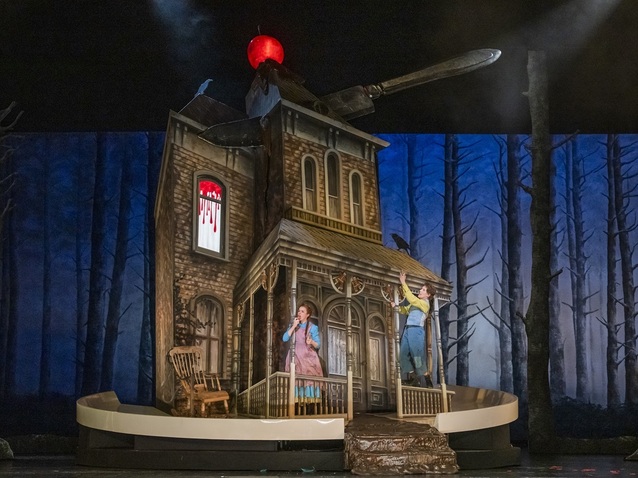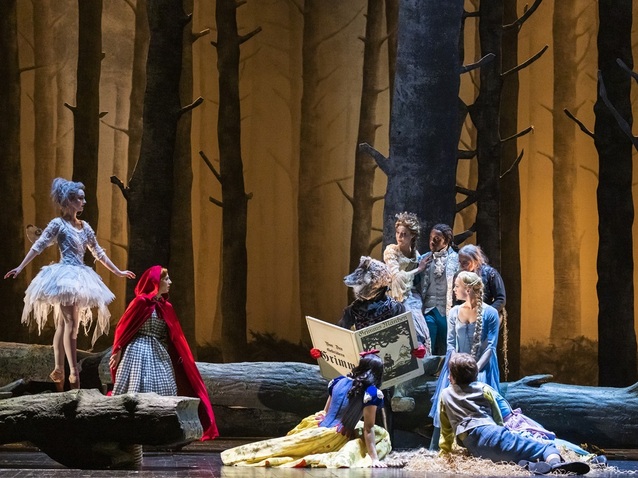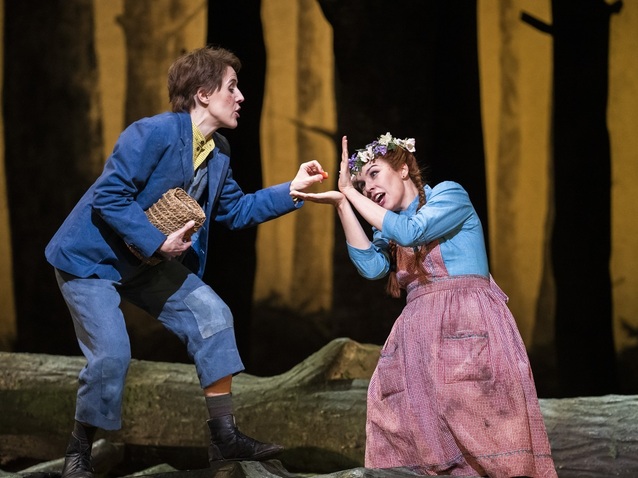 © ROH 2023. Photo Tristram Kenton
© ROH 2023. Photo Tristram Kenton
Engelbert Humperdinck’s Hansel and Gretel, with a libretto by his sister Adelheid Wette, is based on the eponymous fairytale that was recorded by the Brothers Grimm and published in 1812. It follows the Grimm version of the story reasonably closely, although there are a few notable differences including the fact that the Mother here is not intent on losing the children in the forest so that she and her husband might survive the hard times. She sends them there to collect berries as a punishment for misbehaving, and because she needs the food, but is as horrified as anyone when she realises that a Witch lives there who could entice and eat them.
Hansel and Gretel was first performed in Weimar on 23 December 1893, where it was conducted by Richard Strauss, while its Hamburg premiere on 25 September 1894 was led by Gustav Mahler. Considering its illustrious beginnings, and the fact it has never really fallen out of fashion, the Royal Opera House’s own history with the work has been quite chequered. When a new production by Patrice Caurier and Moshe Leiser appeared at Covent Garden in 2008, it was the first time the opera had been seen at the venue since 1937. Fifteen years on, however, and the piece feels like a mainstay of its Christmas season once more, as it is presented alongside classic ballet The Nutcracker and 2021 opera Wolf Witch Giant Fairy. The set for Caurier and Leiser’s version, which was revived in 2010, was quite Expressionistic, but this staging by Antony McDonald, which represents a co-production with San Francisco Opera and first appeared in 2018, has a more realistic and homely quality. The stage curtain presents an idyllic view of the Alps within whose landscape Hansel and Gretel’s small timbered cottage resides. Everything both inside and outside the dwelling suggests a rustic and traditional way of life, although the setting cannot be so long ago as the sink features taps with running water.
The action begins before anyone has even sung a note as during the Overture the front curtain becomes transparent to reveal a prosperous Hansel and Gretel happily enjoying good food and wine with their mother Gertrud and father Peter. Then we cut to a second scene where the food is more scarce, which foreshadows the start of Act I when there is none. This suggests that the family has not lived in poverty forever, but only recently fallen on hard times, which both ties in with the Brothers Grimm tale, and implies that the subsequent behaviour of Gertrud is a response to a situation she is unused to being in.

Production photo of Hansel and Gretel © ROH 2023. Photo Tristram Kenton
Although the cast is different to that which appeared in 2018, the manner in which they render the various family relationships proves to be just as strong. Susan Bickley reveals how Gertrud scolds Hansel and Gretel for doing no work, not because she does not understand that children will be children, but because she sees it as a part of her responsibility to bring them up well. When she does, however, become angry, it is as a result of desperation at having no food, and she soon regrets it. However, even when she sends them out to find berries it derives as much from the need to have food as it does from any requirement to punish them. Similarly, when we hear Darren Jeffery’s Peter singing ‘Ra-la-la-la, ra-la-la-la’ we realise that he is not merely a happy-go-lucky character, oblivious to the struggles that his wife must endure to keep the house together. Rather, he is someone who has had to learn to embrace optimism in order to see himself through such difficult times.
There are also a host of excellent touches so that the smoke coming out of the chimney, which is the result of something cooking in the oven, reaches its zenith when Peter describes the evil Witch. Act II is the most magical, however, where in the forest we see huge insects scale the proscenium arch, and characters from Brothers Grimm and other fairytales appear between the trees. The Traumpantomime, which normally sees fourteen angels gather around Hansel and Gretel to protect them as they sleep, sees all of the fairytale characters take on this role, although the angels are still represented with paper chains. With the dancers being choreographed by movement director Lucy Burge, the Wolf chases Little Red Riding Hood, Prince Charming searches for Cinderella, Rapunzel’s hair is cut and Snow White is just prevented from eating the poisoned apple before everyone forms a tableau around the children with a Brothers Grimm storybook. Special mention should also be made of Isabela Díaz who gives a highly accomplished performance as the Sandman, as does Sarah Dufresne as the Dew Fairy at the start of the following act.
Act III makes the Witch’s gingerbread cottage look exactly like the house in Alfred Hitchcock’s Psycho, complete with ‘quarter wheels’ at the top of its narrow exterior columns. The structure also has a knife sticking out of the top, thus making the roof look like a huge slice of cake, while the windows drip with either blood or cherry sauce. Once the house spins around, it is obvious that the cottage’s tempting qualities are just a facade, but while the truth about it may be clear from the start, the point is that people, and the children in particular, are all too good at simply seeing what they want to see.

Hansel (Anna Stéphany), Gretel (Anna Devin), Hansel and Gretel © ROH 2023. Photo Tristram
The Witch can be played by either a man or a woman, and in 2018 the part was taken by tenor Gerhard Siegel, who has performed Mime in Der Ring des Nibelungen literally hundreds of times. This time around it is assumed by mezzo-soprano Rosie Aldridge, who undergoes a brilliant transformation from pink costumed, almost sickly sweet, old lady to bald headed, back clad Witch, who jumps on her broomstick and flies away.
The highest accolades, however, should go to the pair who are on stage for the vast majority of the evening, namely Anna Stéphany as Hansel and Anna Devin as Gretel. Both enter completely into the spirit of playing the children, with Stéphany revealing some well observed boyish mannerisms and Devin capturing the slightly greater sense of responsibility that Gretel shows. Both execute some effective steps in ‘Mit den Füßchen, tapp tapp tapp’, while Stéphany’s mezzo-soprano also works well with Devin’s soprano to delineate the different genders. Having been provided by Cardinal Vaughan School and The Grey Coat Hospital, the children’s chorus sounds especially good when it appears at the end, while Mark Wigglesworth’s conducting is extremely exciting as it is highly precise while always conveying the right sense of drama for the occasion. The performances are in English, with Kelley Rourke’s translation proving to be as slick as it is undoubtedly skilful, while Hanna Hipp plays Hansel, Lauren Fagan sings Gretel and Tichina Vaughn assumes the role of the Witch for several of them.
By Sam Smith
Hansel and Gretel | 16 December 2023 - 7 January 2024 | Royal Opera House, Covent Garden
the 18 of December, 2023 | Print
Comments